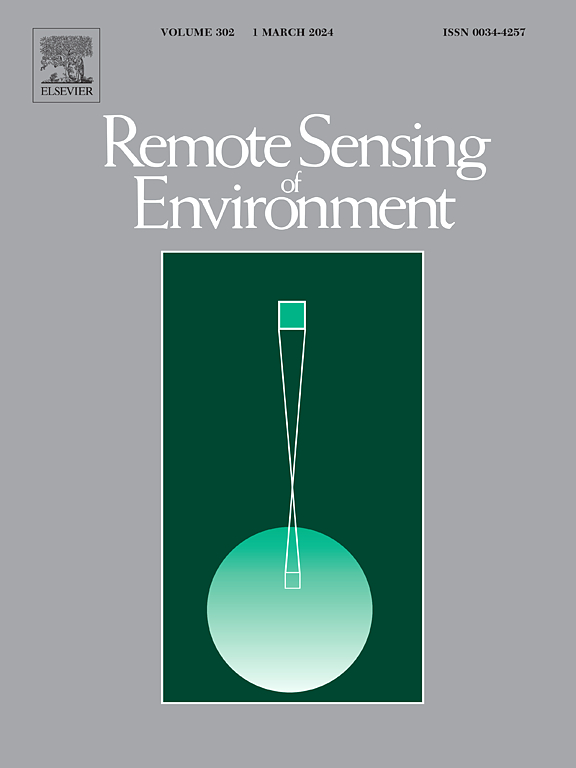Advancing hourly gross primary productivity mapping over East Asia using Himawari-8 AHI and artificial intelligence: Unveiling the impact of aerosol-induced radiation dynamics
IF 11.4
1区 地球科学
Q1 ENVIRONMENTAL SCIENCES
引用次数: 0
Abstract
Advancements in geostationary satellites allow monitoring of terrestrial photosynthesis at sub-daily scales, offering unprecedented opportunities for understanding vegetation productivity. However, at short temporal scales, photosynthesis is highly influenced by illumination conditions, particularly diffuse radiation (Ddif). Existing empirical models often overlook Ddif's impact, leading to uncertainties in hourly gross primary productivity (GPP) mapping. We determined that incorporating Ddif effects into GPP modeling improves clear-sky GPP mapping using Himawari-8. We employed a light gradient boosting machine (LGBM) considering Ddif and compared it with other empirical models: parametric, regression, and machine learning. The LGBM outperformed others, achieving an R2 of 0.8146 and root mean square error of 2.848 μmol CO₂/m2/s against ground observations from 2020 to 2021. To investigate input variable contributions in LGBM predictions, we performed SHapely Additive exPlanation (SHAP) analysis. Results confirmed that aerosol optical depth (AOD) had a greater impact during morning and evening when Ddif influence increased due to solar path length. Hourly GPP maps over East Asia from 2020 to 2021 using the LGBM demonstrated that diurnal patterns differ by landcover, with variations observed in latitudinal profiles. This underscores the need to examine GPP spatial distribution at high frequency. We confirmed that the spatial distribution of AOD SHAP values varied over time, highlighting temporal dynamics of aerosol effects. Our findings demonstrate the necessity of GPP mapping using geostationary satellites and suggest various impact studies can use our proposed framework. This approach provides a valuable tool for understanding vegetation's rapid response to atmospheric aerosols, contributing to more accurate ecosystem flux modeling.
利用Himawari-8 AHI和人工智能推进东亚每小时总初级生产力制图:揭示气溶胶诱导辐射动力学的影响
地球同步卫星的进步使我们能够在亚日尺度上监测陆地光合作用,为了解植被生产力提供了前所未有的机会。然而,在短时间尺度上,光合作用受到光照条件的高度影响,特别是漫射辐射(Ddif)。现有的经验模型往往忽略了Ddif的影响,导致小时总初级生产率(GPP)映射的不确定性。我们确定将Ddif效应纳入GPP建模可以改善使用Himawari-8绘制晴空GPP地图的效果。我们采用了考虑Ddif的光梯度增强机(LGBM),并将其与其他经验模型(参数模型、回归模型和机器学习模型)进行了比较。与2020 - 2021年地面观测数据相比,LGBM的R2为0.8146,均方根误差为2.848 μmol CO₂/m2/s。为了研究LGBM预测中输入变量的贡献,我们进行了SHapely加性解释(SHAP)分析。结果证实,气溶胶光学深度(AOD)在早晨和晚上的影响更大,当Ddif的影响随着太阳路径长度的增加而增加。利用LGBM在2020 - 2021年东亚地区每小时GPP地图显示,日模式因土地覆盖而异,在纬向剖面上观察到变化。这强调了在高频率下检查GPP空间分布的必要性。我们证实了AOD SHAP值的空间分布随时间变化,突出了气溶胶效应的时间动态。我们的研究结果证明了使用地球同步卫星绘制GPP地图的必要性,并建议各种影响研究可以使用我们提出的框架。该方法为了解植被对大气气溶胶的快速响应提供了有价值的工具,有助于更准确地建立生态系统通量模型。
本文章由计算机程序翻译,如有差异,请以英文原文为准。
求助全文
约1分钟内获得全文
求助全文
来源期刊

Remote Sensing of Environment
环境科学-成像科学与照相技术
CiteScore
25.10
自引率
8.90%
发文量
455
审稿时长
53 days
期刊介绍:
Remote Sensing of Environment (RSE) serves the Earth observation community by disseminating results on the theory, science, applications, and technology that contribute to advancing the field of remote sensing. With a thoroughly interdisciplinary approach, RSE encompasses terrestrial, oceanic, and atmospheric sensing.
The journal emphasizes biophysical and quantitative approaches to remote sensing at local to global scales, covering a diverse range of applications and techniques.
RSE serves as a vital platform for the exchange of knowledge and advancements in the dynamic field of remote sensing.
 求助内容:
求助内容: 应助结果提醒方式:
应助结果提醒方式:


